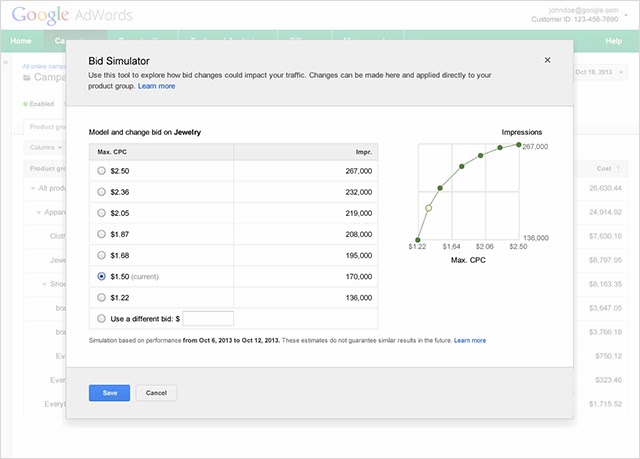People are constantly connected, using multiple devices throughout the
day to shop, communicate and stay entertained. A September 2013 study
of multi-device consumers found that over 90% move sequentially between
several screens for everyday activities like booking a hotel or shopping
for electronics.
As consumers are increasingly on the go and switching between devices,
marketers are telling us they want to see a more complete and accurate
picture of how their online advertising drives conversions. Conversions
can come in many forms: visits to stores, phone calls, app downloads,
website sales or purchases made after consulting various devices.
Getting better insight into these complex purchase paths can help you
optimize your online advertising and allocate budget more effectively.
Introducing Estimated Total Conversions
Today, we are introducing
Estimated Total Conversions
for search ads on Google.com. This is an exciting first step to give
marketers more insight into how AdWords drives conversions for your
business by showing you both the conversions you see today, like online
sales, as well as an estimate of conversions that take multiple devices
to complete. Over time, we’ll be adding other conversion types like
phone calls and store visits as well as conversions from ads on our
search and display network.
Estimated Total Conversions will provide you with a holistic view
of all of the conversions driven by your Google search advertising that
can be used to make important decisions like how much to bid and how to
assign budget across your various marketing channels. For the last few
years, many sophisticated advertisers have been using their own
analysis to get to these insights. Today, we are beginning to bring
this level of insight and measurement to all advertisers.
Estimated cross-device conversions
Estimated cross-device conversions is the first new conversion type to launch as part of
Estimated Total Conversions. Cross-device conversions start as a click on a search ad on Google.com on one device and end as a conversion on another device (or in a different web browser on the same device).
For example, say someone shops for “blue jeans” on her mobile phone
while waiting for the morning train. She clicks on a mobile ad for ABC
Blue Jeans. When she gets to her office, she goes directly to the ABC
website to make a purchase. This is an example of a cross-device
conversion. We calculate cross-device conversions using a sample of
data from users who signed into multiple devices.
Estimated cross-device conversions will begin rolling out
globally to all AdWords advertisers starting today and continuing over
the next few weeks. To see these new statistics, you’ll need AdWords conversion tracking and a sufficient volume of conversions on which to base a reliable estimate.
In the last few months, we’ve analyzed data across thousands of AdWords
advertisers to learn more about cross-device conversion patterns.
When advertisers in the travel industry use AdWords estimated cross-device conversions,
they are able to measure 8% more conversions, on average, than they did
before. In addition, they can now measure 33% more conversions that
originated on a mobile phone and later converted on different device.
This helps them attribute all those sales -- from customers who
searched for flights and hotels on their mobile phones and then made a
purchase from another device -- to the right ad.
Similarly, other verticals, like entertainment and retail are also
seeing positive results. Businesses in these industries are now able to
measure 12% and 7% more conversions, respectively, than they could
before using Estimated Total Conversions.
Sean Singleton, Marketing Manager at American Apparel noted that, "We
always knew our online ad investment was influencing conversions across
devices, but we didn't know how to begin estimating these numbers. Once
we saw that 5.3% more conversions could be attributed to cross-device
conversions in AdWords, we knew we could more accurately calculate the
value we were receiving from each ad click. We also learned that mobile
ads are driving 16% more conversions than we thought, so we are now
investing more into this channel to gain more sales.”
More results from other verticals can be seen below.

Paving the way for marketers to measure the full value of their online advertising
We are committed to helping you gain insight into the new conversion
types that are part of a constantly connected, multi-screen world so
that you can make the best advertising decisions possible. In addition
to cross-device conversions, both phone calls and store visits will be
included as part of Estimated Total Conversions in the coming months.
These are important conversions to consider — people make more than 40M calls to businesses
each month directly from Google ads and are often looking for physical
store locations when they search on Google, particularly on the go.




